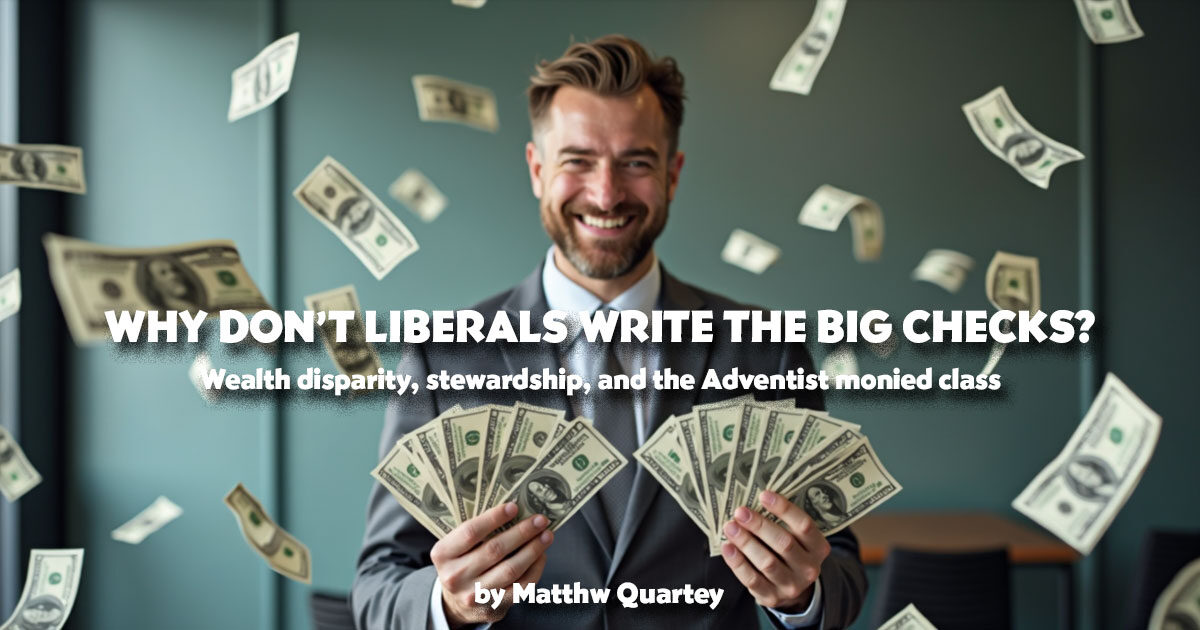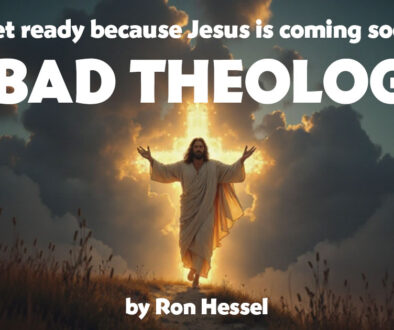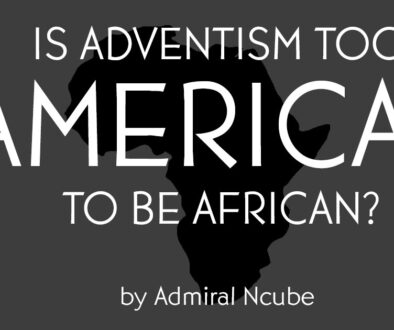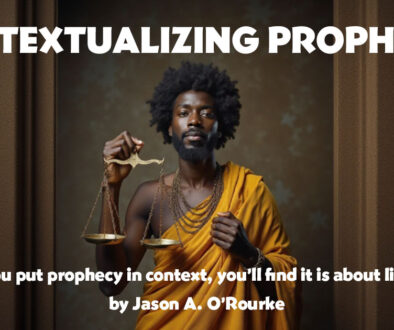Why Don’t Liberals Write the Big Checks? Wealth disparity, stewardship, and the Adventist monied class
by Matthew Quartey | 23 May 2025 |
At Sabbath School a few months ago, our class discussions strayed from the study topic and segued into funding and budgeting difficulties at Andrews University—problems that threatened to unleash deep institutional cuts. The question was whether the school’s longstanding funding model, which relies heavily on student fees and General Conference appropriations, was adequate for operating contemporary private higher education.
“No!” said some who favored an endowment template. Our discussion leader countered that Andrews, the flagship of the church’s many global colleges and universities, does not have a strong conservative support base needed to write the “big checks” for an endowment alternative. His next question: “Why don’t liberals write the big checks?”
Where wealth comes from
His question presupposes that cultural and religious conservatives “put their money where their mouth is” and liberals don’t. That is an unjustified assumption. It embodies a popular but misleading narrative that conservatives are more generous.
In fact, I’m not sure we can begin a good discussion about the size of our giving—if that is even a good basis for determining the value of our “gifts”—without questioning how conservatives presumably come to possess extra wealth to enable their philanthropy. Consider that in Mark’s (12:41-44) story of the widow’s mite, Jesus was famously unimpressed by the apparent larger offerings of wealthier donors. He knew that the true worth of the widow’s giving represented a far greater share of what she owned than the bigger amounts the rich flaunted.
Wealth, whether self-generated or passed down generationally, is not created in a vacuum. Usually it is the result of a barter between capital and labor, where capital almost always dictates labor’s worth. A wealth gap is created when labor is unfairly compensated. Left unchecked it leads to a depletion of the middle class, ultimately triggering a dependency of the poor. The underlying problem is the massive inequity that in turn creates the perception that we need a rich donor class to shore up the ensuing social shortfall.
My position is that if entrepreneurs, particularly Christians, operated their businesses by committing to a fairer compensation model, the increasingly sharp divide between the ultra-rich and the working poor would not be as pronounced or as damning.
But the commitment to fair compensation is inconsistent. A cursory examination of how conservatives, who appear to dominate the “monied” class, come into their riches, reveals some basic uncomfortable truths: some underpay their workers, or overcharge for their products/services.
One could add as a corollary possible unethical practices—see Purdue Pharma. Some successful business types combine all three vices, making the resulting poverty worse.
Wealth disparity
Could I be overstating the situation? Perhaps. But we do find examples in entrepreneurial history to support these conclusions.
Consider that regardless of an entrepreneur’s individual ingenuity, they cannot single-handedly make all the goods or provide all the services that eventually make them rich. Invariably they need assistance from others. Call them partners, investors, workers—whatever. How these “helpers” are remunerated for their roles in making the business thrive is determined in large part by whether an owner or company is fair to its workers or exploits their contributions.
A good way to measure where a business falls on the fair/exploitative continuum is to compare the pay differential between the highest and lowest workers in the establishment. The poles on this scale have dramatically widened in the past few decades, creating a workplace culture where business “owners” have become overly wealthy, too often at the expense of lower wage earners.
Take the benefits structure at Elon Musk’s Tesla company. Tesla’s board—which an appeals court judge ruled is full of friends he personally appointed—offered to pay him $56 billion over 10 years, which is roughly $5.6 billion a year. Shareholders sued, and the judge agreed with them that the pay was excessive. The board was undeterred and took the matter to Tesla’s shareholders to ratify its recommendations.
In contrast to Musk’s proposed annual $5.6 billion package, the lowest 10 percentile earners at Tesla make around $60,000 a year. This means Musk’s salary is 93,000 times what the lowest 10 percent in the company receive annually.
Reduce Musk’s benefits by two or three billion dollars a year and it will not materially impact his personal financial wellbeing. But distribute that same $3 billion among Tesler’s lowest ten percentile wage earners, and the result is transformative. Such a gesture could more than double their salaries. Suddenly these low earners can more likely afford a mortgage for a house or pay for their children’s college expenses.
Is this success?
The issue is not how much less a business owner could get away with paying its employees, but whether the business will succeed without the services of its lowest paid staff. Tesla pays some of its receptionists a mere $40,000 a year, but it is questionable if the company could operate smoothly without them. Likewise with those who keep the bathrooms clean, or assembly line workers who operate the machines that produce the cars, or the drivers who chauffeur corporate heads around. They don’t all have the same role, but eliminate them and the company’s operation would be less cohesive.
It is this type of disparity that has created a situation where the world’s 10 richest people collectively own more than the combined wealth of almost half of the entire world population. The French revolution, an outgrowth of the deep resentment and feeling of injustice among the working class, is testament to the unsustainability of the current social inequality if left unaddressed.
This is not an argument for an undifferentiated pay structure in the workplace, but rather one against unfairness, disproportion, and apparent greed. There are other models in the industrialized west, in places like Scandinavia, where the pay gap between top management/business owners and their workers is not as wide as in many other contemporary economies, notably the United States.
This has not always been the case. In an America of not-too-distant memory, the working class had a shot at upward mobility. This was due in large part to workforce unionization. It meant they had a fair chance of homeownership and the ability to send their children to college without having to borrow their way into unsustainable debt. I contend that the current widespread pay inequity is a significant reason why wage earners are losing ground.
Historical monopolization
While shortchanging of workers in exchange for rapid personal wealth is now normalized by the likes of Musk, Bezos, and Zuckerberg, history is replete with a long line of actors – Carnegie, Frick, Gould, Fisk, Vanderbilt, Astor – who at different times achieved the same ends by means no less exploitative. The rise of John D Rockefeller, the world’s first true billionaire, is instructive for our purposes, as his Christian connection was often cited as inspiration of his philanthropy.
Rockefeller’s “art” was to corner the market, thus setting his own prices for the goods he supplied. He started in oil, and through aggressive anti-competitive practices quickly grew Ohio Standard Oil Company into a trust with a virtual national monopoly in oil. His, and similar ruthless and questionable business behaviors, would lead to congressional enactment of the Sherman Antitrust Act in 1890, which aimed at combating monopolistic business practices. Rockefeller attempted to evade this by dissolving his trust company into multiple “separate” companies under one management control, but this would be ruled illegal by the U. S. Supreme Court in 1911.
Having acquired his fortune through questionable ethics, this “devout” Baptist devoted himself almost exclusively to his second act: writing the checks that demonstrated his goodwill. The University of Chicago and Rockefeller University in New York owe their existence to his largesse. Today, his legacy endures through the activities of the Rockefeller Foundation.
The question is whether Rockefeller’s post-business philanthropy excuses the dubious business practices that made him rich in the first place. There is a tendency in Christian circles to grade rich Christians on a curve with regard to their ethics. A local church elder once conceded as much, arguing that “You don’t get to be a multimillionaire by being a nice person. You step on people’s feet, skirt the laws, or underpay your employees.” As though ethical behavior is only a suggestion on the Christian’s road to amassing wealth.
What was left unsaid but clearly inferred was, “It’s OK as long as you do good with your gains.”
Yes, conservative businesspeople often do write the big checks. It is also true that these checks are not necessarily free if they increase poverty, legitimize unethical workplace culture, and/or whitewash an exploitative past. More than any other group, Christians should be alert to such conduct and speak against it, even if doing so costs the church these checks. Being silent condones greed, whether the perpetrators are conscious of it or not.
Have you wondered why buildings funded by rich patrons usually have their names emblazoned on them? They could put up these structures anonymously but rarely do. A young visionary carpenter once advised. “When you give… do not let your left hand know what your right hand is doing.” Yet this is often ignored. If this rule were applied, some of the big checks might stop.
The Adventist monied class
In Adventism we have a monied class who tends to have increased access to our leaders. They are often right-of-center, and members of Adventist Laymen’s Services & Industries (ASI). These people, mostly business-oriented men, fund expensive evangelistic projects for the church. President Wilson’s pet project, global free distribution of Ellen White’s hundred-year-old The Great Controversy, is possible mainly through ASI-related “private” funding, which might total multiple hundred millions of dollars. These same men tend to have President Wilson’s ear about church policy and politics.
Now back to the original question that prompted this essay to consider whether liberals give to causes they believe in. They certainly do. The difference between the giving practices of liberals and conservatives may well center on motives. Could it be that, when liberals write their likely smaller checks, they do it with little expectation of recognition, as such checks are not large enough to attract notice? Yet when they are inspired by a cause, they still swell the “offering plates” with their collective widows’ mites and through the power of anonymity make a substantial difference.
This happened with former president Barack Obama’s two White House campaigns. His $68 average donation from small backers overwhelmed the traditional big donors by a wide margin, and helped catapult him twice to the presidency.
Maybe Andrews University’s budgetary difficulties stem from concentrating too narrowly on a perceived rich donor class. The school’s current brochures boast of over a hundred thousand alumni worldwide. While most of them are not multi-millionaires, perhaps the university could still harness their collective potential, because though “poor,” they have strength in numbers and could shore up the school’s financial stress.
 Matthew Quartey writes from Berrien Springs, Michigan, where he engages the outskirts of Seventh-day Adventist thought.
Matthew Quartey writes from Berrien Springs, Michigan, where he engages the outskirts of Seventh-day Adventist thought.




